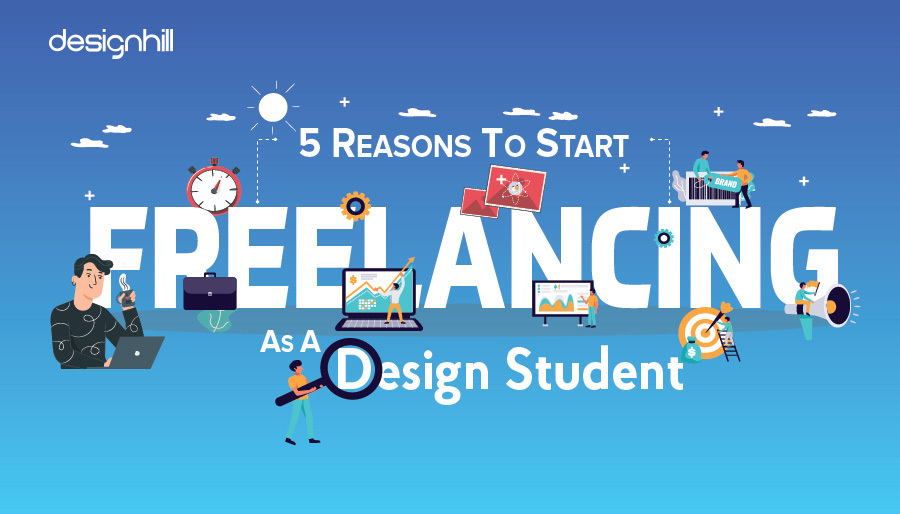Embracing Independence: 5 Compelling Reasons to Start Freelancing as a Design Student

Introduction:
In the dynamic and ever-evolving field of design, the traditional boundaries of employment are shifting, providing unique opportunities for design students to embark on freelancing journeys. While the academic world equips students with foundational skills, freelancing offers a real-world platform to hone those talents, gain practical experience, and cultivate a professional identity. This comprehensive guide explores five compelling reasons for design students to step into the world of freelancing, embracing the independence, challenges, and rewards it brings.
- Real-world Application of Skills:
Design students often find themselves immersed in academic projects that provide a theoretical understanding of design principles. However, freelancing allows them to translate these theories into practical applications. By taking on real-world projects, students can apply their skills in graphic design, web development, illustration, or other design disciplines, gaining valuable experience that goes beyond the confines of a classroom.
Practical Insight: Freelancing provides a firsthand look into the practical challenges and intricacies of client briefs, project timelines, and the iterative design process. This exposure helps design students refine their problem-solving skills and understand how design decisions impact the end-user or client.
Building a Portfolio: Actively freelancing enables design students to build a diverse and robust portfolio. A portfolio filled with actual client projects not only showcases technical skills but also demonstrates adaptability, creativity, and the ability to meet client expectations – a vital aspect when entering the competitive design job market.
- Flexible Schedule and Independence:
One of the most alluring aspects of freelancing is the autonomy it offers. Design students can mold their work hours around their academic commitments, making freelancing a flexible and accessible option. The ability to control one’s schedule allows students to pursue freelancing without compromising their academic pursuits.
Balancing Work and Studies: Freelancing allows design students to strike a balance between academic responsibilities and professional work. They can take on projects during breaks, weekends, or evenings, tailoring their freelancing commitments to align with their academic schedule.
Preparation for Post-Graduation: Developing time management and organizational skills during freelancing not only aids in managing current commitments but also prepares design students for the multifaceted demands of post-graduation professional life.
- Networking and Industry Exposure:
Freelancing exposes design students to a diverse range of clients, collaborators, and industries. This network-building opportunity goes beyond the classroom and acquaints students with professionals from various sectors seeking design services.
Expanding Professional Connections: Networking while freelancing introduces design students to potential employers, collaborators, and mentors. These connections can prove invaluable when seeking internships, job opportunities, or even advice on navigating the design industry.
Understanding Client Dynamics: Interacting with clients during freelancing engagements provides insights into client expectations, communication nuances, and project management. This experience becomes a crucial asset as design students transition from academic settings to the professional realm.
- Financial Independence and Skill Valuation:
Freelancing offers design students a pathway to financial independence. By monetizing their skills, students can earn income while still studying, providing a sense of empowerment and financial stability.
Monetizing Design Talents: Freelancing allows design students to assess the market value of their skills. As they undertake paid projects, they gain a realistic understanding of how their design expertise is valued in the industry.
Building a Professional Identity: Earning money through freelancing contributes to the development of a professional identity. Design students can begin to see themselves not just as learners but as contributors to the design community, establishing confidence in their abilities.
- Portfolio Diversity and Skill Specialization:
Freelancing enables design students to explore diverse projects and industries, fostering skill specialization and a niche focus within the expansive field of design.
Exploring Design Specializations: Through freelancing, design students can explore specific areas of interest within design – whether it be branding, UX/UI design, illustration, or web development. This exploration aids in the discovery of personal preferences and passions within the broader design landscape.
Showcasing Versatility: A diverse freelancing portfolio showcases a design student’s versatility and adaptability. Exposure to different project types not only hones existing skills but also encourages the acquisition of new ones, enhancing the overall skill set.
Conclusion:
Embarking on a freelancing journey as a design student is not just about financial gains; it’s a holistic and transformative experience. From gaining practical insights and building a robust portfolio to enjoying flexible schedules and fostering professional connections, freelancing offers design students a myriad of benefits. The skills acquired during freelancing – be it time management, client communication, or industry networking – contribute to a well-rounded design education that extends beyond the confines of a classroom. Embracing the independence and challenges of freelancing positions design students as proactive contributors to the design community, setting the stage for a promising and fulfilling professional journey.







